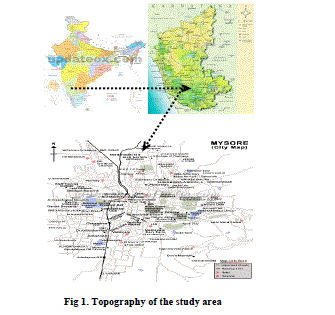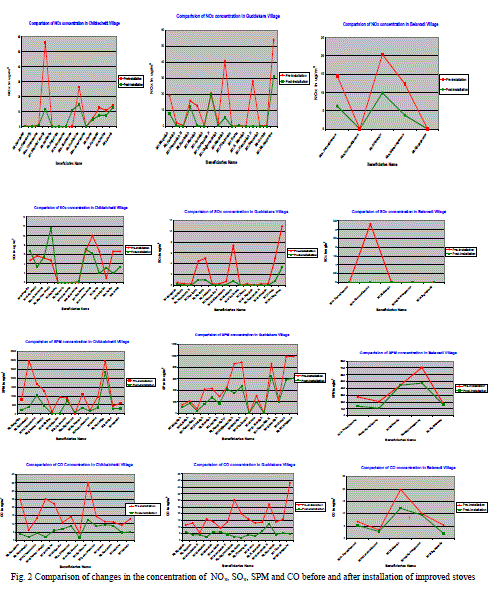ISSN ONLINE(2319-8753)PRINT(2347-6710)
ISSN ONLINE(2319-8753)PRINT(2347-6710)
A.H.Rajanna1, D.C.Shyamala1, S.L.Belagali2
|
| Related article at Pubmed, Scholar Google |
Visit for more related articles at International Journal of Innovative Research in Science, Engineering and Technology
Wide variety of epidemiological diseases occur due to adverse impact of indoor air quality. The present study was carried out to know the impact of the improved chulha during the year 2012, in three rural areas of Chamarajanagar district of Karnataka state in Southern India. A questionnaire survey was performed to recognize the impacts in daily activity patterns, socioeconomic characteristics of cooking women in the households. Indoor air quality parameters like, NOx, SOx, SPM were monitored using High Volume Air Sampler and concentrations of carbon monoxide was monitored using Gas analyzer on an hourly basis. Based on the experimental results comparative study reveals that, reduction in the concentration of NOx (51.24%), SOx (20.24%), SPM (58.69%) and CO (44.75%) and changes in socioeconomic, environmental and health impacts was taking place after installation of chulha in the studied areas and recommended to extend these improved chulha installation scheme to further rural areas in India.
Keywords |
| Text detection, Inpainting, Morphological operations, Connected component labelling. |
INTRODUCTION |
| Even today, one half of the world’s population, 95 % in poor countries [1] and more than 90 % households of India [2] still rely on traditional solid fuels. Most of the people make use of traditional three stone fires, using various mixtures of solid fuels such as biomass, coal, animal dung, crop residues, typically dried residues etc. The incomplete combustion releases hundreds of complex toxic hazardous pollutants [3]. Excessive exposure to these emissions is associated with several adverse health effects, especially for women and children [4], [5], [6], [7], [8]. Solid fuels release noxious pollutants including particulate matter, carbon monoxide, nitrogen dioxide, sulphur dioxide, formaldehyde and carcinogens. Wood smoke emissions can cause short and long term health effects including acute respiratory infections, tuberculosis, asthma, chronic obstructive pulmonary diseases, headache blindness and reduced birth weight [9], [10], [11], [12], [13]. The exposure to indoor smoke is particularly high among women, because they are mainly responsible for cooking food. Most of the researchers like [3], [14], [15], [16], [17], [18], [19] have carried out indoor air pollution studies in different areas but, detailed study for the improved chulha invention and its impact has not been carried out in southern India. Keeping this in view, monitoring of indoor air pollutants and evaluation of the socioeconomic impacts ofimproved chulha invention was carried in three rural areas of Chamaraj Nagar district of Karnataka state in Southern India. |
II. BACKGROUND OF THE STUDY AREA |
| For the present study, 40 houses were selected at Chikkelchetti, Guddekere and Belavadi villages of Gundlupet Taluk situated in Chamarajanagar district. The Chamarajanagar District was carved out of Mysore District, which has 4 taluks-namely Chamarajanagar, Gundlupet, Kollegal and Yelandur. Gundlupet is located to the west of Chamarajanagar Taluk. Bordering to this taluk to south are Kerala and Tamil Nadu States. The map of the study area is given in Fig 1. In this particular location, most of the houses were built close together or attached to each other, separated by a wall. Because of the level of the poverty, crowding/congestion, large family size & more than one family living in the single rooming house. Gundlupet Taluk has a forest area of 44,859 hectares. To the south lies the Bandipur forest with an area of 60 sq. kms. This forest is famous for its sandalwood trees. Indian Teak, Honne, Nandi, Jack fruit , Sampige trees. It receives very little rainfall i.e. an average of 693 mm of rainfall per year. The soil is sand mix useful for Jowar, Ragi, Castor crop etc. Most of the people get fuel wood from the nearest forest for cooking. |
 |
III. MATERIALS AND METHODS |
| Installation of improved stoves by Philips Electronics India Limited in collaboration with jungle scapes were installed with the help of local entrepreneurs. The study area was selected based on the socioeconomic background of the rural people, mainly poor soligas residing near the forest area. A questionnaire survey was conducted for every household before and after installation of chulha for getting information regarding the socioeconomic conditions of the people, the efficiency of both the stove and status of indoor air quality. Air samples were collected with the help of High Volume Air Sampler. Indoor air was drawn through pre weighed Whatman glass fibre filter papers for 1 hour SPM in the range of 10 microns was calculated by taking the differences between initial and final weights of the filter paper. NOx and SOx were collected by drawing air at an average flow rate of 1 L/min in each house, through sodium hydroxide-sodium arsenite and potassium tetrachloro mercurate respectively as absorbing solutions. NOX and SOX were determined by Jacob-Hochheeiserspectrophotometric method and modified West and Gaeke spectrophotometric method respectively. Concentration of Carbon monoxide was monitored using Gas analyzer (Gas Alert CO) and Questionnaire survey was performed to recognize the daily activity pattern, socioeconomic characteristics, cooking conditions and to assess symptoms of disorders of cooking women in the households. It was also documented, the usage scenario of existing as well as improved stoves through pictures using a digital camera and recorded the observation. |
 |
| Figure 2 reveals the comparison in the concentrations of gaseous pollutants among traditional and improved stoves. The majority of households was found to use traditional stoves (three stones with mud coating) without chimney is quite common in the above said areas. Higher concentrations of gaseous pollutants were noticed before the installation of Chulha’s, because of improper installation of traditional stoves, leakage of large amounts of gaseous pollutants and particulate matters. Usage of crop residues as an energy source, tobacco smoking, de-nitrification and methane emission from the surrounding areas of microbial activities were also responsible for high concentration of gaseous pollutants. Further, kitchen type, ventilation was also found to be good predictors of women's health. Experimental results show that, the concentrations of gaseous pollutants in traditional stoves ranged from zero to 56.178x10-6 μg/m3 for NOX, zero to 6.666 μg/m3 for SOX, 114.0 μg/m3 to 2969 μg/m3 for SPM and 4.33 ppm. to 25.14 ppm. for CO. After installation of improved Chulha, the concentrations ranged from zero to 16.385x10-6 μg/m3 for NOX, zero to 11.66 μg/m3 for SOX, 15.7 μg/m3 to 2340.08 μg/m3 for SPM and 1.8 ppm to 12.6 ppm for CO. Meanwhile, 47.27 %, 44.51 % & 39.18 % reduction in NOX, SPM & CO concentration in Chikkelchetti households was noticed. Concentrations in the traditional stoves ranged from 4.681x10-6 μg/m3 to 53.833x10-6 μg/m3 for NOX, 0.238 μg/m3 to 10.952 μg/m3 for SOX, 78.3 μg/m3 to 987.2 μg/m3 for SPM and 5.6 ppm to 43.2 ppm for CO. After installation of Chulha’s, concentrations ranged from zero to 30.898x10-6 μg/m3 for NOX, zero to 1 μg/m3 for SOX, 40.7 μg/m3 to 645 μg/m3 for SPM and 2 ppm to 12.3 ppm for CO. Meanwhile, 46.04 %, 20.54 %, 57.78 % & 29.11 % reduction of NOX, SOX, SPM & CO concentration in Guddekere households and concentrations in traditional stoves ranged from zero to 10.486x10-6 μg/m3 for NOX, zero to 3.66 μg/m3 for SOX, 259.8 μg/m3 to 706.06 μg/m3 for SPM and 3.4 ppm to 19.8 ppm for CO. After installation of Chulha’s, concentration ranged from zero to 9.831x10-6 μg/m3 for NOX, nil for SOX, 110.1 μg/m3 to 477.7 μg/m3 for SPM and 2.8 ppm to 12.2 ppm for CO. Meanwhile 60.43 %, 73.77 % & 65.96 % reduction in NOX, SPM & CO concentration in Belavadi households was noticed. Some houses showed high concentration, even after Chulha installation, which might be due to firing in the surrounding environment. On an average 51.24 %, 20.54 %, 58.691 % and 44.756 % reduction in the concentration of NOX, SOX, SPM and CO in the studied areas was observed. Newly designed Chulha’s made up of concrete containing iron metal to get quick heating of utensils, which has space for easy movement of gases and suspended particulate matters. The body of the Chulha’s plastered with mud prevents leakage of fumes and has well designed mouth for fitting the vessels and has special arrangements for removal of ash. Moreover, Chulha’s had well designed chimney for discharge of fumes at higher altitudes, which helps to reduce in indoor air pollution. Questionnaire survey conducted for women during cooking, shows that, 95% of the sampled women were getting the time to interact with neighbors, 80% respondents get less health symptoms and 20 % respondents got income during free time and socioeconomic changes took place, environmental and health impacts were noticed after installation of Chulha in the studied areas.Compared to traditional cooking practices improved stoves can save up to 12.5-20 % fuel, health benefits to women and children, Poverty alleviation and women’s empowerment as women will spend less time in gathering fuel wood. This will enable them to focus on other activities such as earning extra income, biodiversity conservation and reduced forest degradation through reduced pressure on forests. |
V. CONCLUSION |
| Based on the experimental results and questionnaire survey it was observed that, reduction in the concentration of NOx (51.24%), SOx (20.24%), SPM (58.69%) and CO (44.75%) and changes in socioeconomic, environmental and health impacts were taking place after installation of chulha in the studied areas and recommended to extend these improved chulha installation scheme to further rural areas in India. |
ACKNOWLEDGMENT |
| Mr.Rajanna A.H and Mrs. Shyamala D.C are grateful to Philips Electronics India Ltd., Gurgaon, for providing financial assistance to carry out the above work |
References |
|